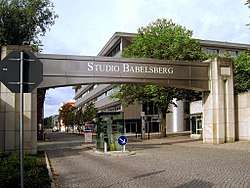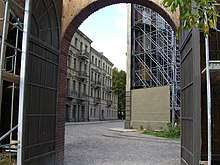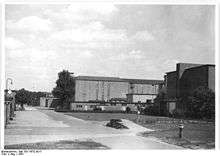Babelsberg Studio
Babelsberg Film Studio (German: Filmstudio Babelsberg, FWB: BG1), located in Potsdam-Babelsberg outside Berlin, Germany, is the oldest large-scale film studio in the world, producing films since 1912. With a total area of about 460,000 square metres (5,000,000 sq ft) and a studio area of about 25,000 square metres (270,000 sq ft) it is Europe's largest film studio.[2][3]

| Incentive GmbH | |
| ISIN | DE000A0D9UR4 |
| Industry | filmmaking |
| Founded | 1912 Germany |
| Headquarters | Germany |
| Revenue | 57,500,000 euro (2010) |
Number of employees | 92[1] (31 December 2017) |
| Website | www |
Hundreds of films, including Fritz Lang's Metropolis and Josef von Sternberg's The Blue Angel were filmed there. More recent productions include V for Vendetta, Captain America: Civil War, Æon Flux, The Bourne Ultimatum, Valkyrie, Inglourious Basterds, Cloud Atlas, The Grand Budapest Hotel, The Hunger Games, and Isle of Dogs.
Today, Studio Babelsberg remains operational mainly for feature film productions. Furthermore, it acts as co-producer on international high budget productions.
History


In 1911, the film production company Deutsche Bioscope built its first glasshouse film studio (early studios designed to take advantage of natural light) in Neubabelsberg. The company had been originally formed by Jules Greenbaum in 1899 and incorporated in 1902.[4][5] As his business increased, Greenbaum made a deal with the chemist Carl Moritz Schleussner of the photochemicals firm Schleussner AG in Frankfurt/Main. Carl Schleussner had been involved since 1896 in producing negative film stock for Röntgen photography soon after its discovery.[6] In February 1908 Carl Schleussner bought a majority share in Deutsche Bioscop as a film manufacturing, duplicating and sales operation, for a 2/3 share of 140,000 marks, with 1/3 provided by Jules Greenbaum & his brother Max. Ownership of Deutsche Bioscop was transferred to Schleussner AG and registered on 27 February 1908: Schleussner bought out the Greenbaums' remaining share of Deutsche Bioscop in 1909.[7]
The first filming in Babelsberg began as early as February 1912 for The Dance of Death by Danish director Urban Gad. In 1920 the Deutsche Bioscop Gesellschaft merged with Erich Pommer's Decla-Film GmbH to form „Decla Bioscop“. In 1928, Decla-Bioscop merged with Universum Film AG (Ufa) which had been founded in 1917. This company built the large studio (which is now known as the "Marlene Dietrich Halle") in 1926 for the major film production of Metropolis by Fritz Lang.
The first German sound stage in Babelsberg, the Tonkreuz, was built during 1929, to make use of the Tri-Ergon sound-on-film process to which Ufa acquired the rights. Ufa's first successful full-sound film Melodie des Herzens/Melody of the Heart with Willy Fritsch was in fact made in Hungary in 1929,[8] although this was followed in April 1930 by the premiere of The Blue Angel (which was made at Babelsberg)[9] by Josef von Sternberg, with Marlene Dietrich and Emil Jannings in the main roles.
From 1933 to 1945, around 1,000 feature films were made in the studios and on the studio lot. Under the direction of Hitler's propaganda chief Joseph Goebbels, the studio churned out hundreds of films including Leni Riefenstahl's openly propagandistic Triumph of the Will (1935). The virulently anti-Semitic propaganda film Jud Süss (The Jew Süss) (1940), was also made at Babelsberg.[10]
On May 17, 1946 the DEFA (Deutsche Film AG) was established, producing over 800 feature films, including 150 children's films. In addition, over 600 films were made for television from 1959 to 1990. The DEFA period was honored by a retrospective at the Museum of Modern Art (MOMA) in New York City in 2005.
After the fall of the Berlin Wall, the Treuhand took over the responsibility for the privatisation of the former DEFA. In August 1992, the Treuhandanstalt sold the former DEFA film studios in Babelsberg to the French group Compagnie Générale des Eaux (later absorbed into Vivendi Universal). Over the following 12 years the company invested around €500 million updating the studio's infrastructure.
In July 2004, Vivendi sold Studio Babelsberg to the investment company FBB (Filmbetriebe Berlin Brandenburg GmbH), which has Carl Woebcken and Christoph Fisser as shareholders. In Spring of 2005, the restructured studio presented an initial public offering and began trading on the free market.
2007 was the most profitable year since the Studio's privatization in 1992 - 12 feature films were shot at Studio Babelsberg, among them Valkyrie with Tom Cruise, The International with Clive Owen, and The Reader with Kate Winslet.
In 2008 Studio Babelsberg and Hollywood producer Joel Silver formed a strategic alliance to produce feature films from the Dark Castle production slate at the world’s oldest film studio.
Recent co-productions of Studio Babelsberg include Quentin Tarantino's Inglourious Basterds (released 2009), Roman Polanski's The Ghost Writer (2010), Brian De Palma's Passion (2012), and George Clooney's The Monuments Men (2014).
Notable films shot at Babelsberg Studios
- Der müde Tod (1921)
- Dr. Mabuse, der Spieler (1922)
- Die Nibelungen (1924)
- Metropolis (1927)
- Spione (1928)
- Frau im Mond (1929)
- Der blaue Engel (1930)
- La Habanera (1937)
- Jud Süß (1940)
- Die Mörder sind unter uns (1946)
- Das Beil von Wandsbek (1951)
- Die Geschichte vom kleinen Muck (1953)
- Das singende, klingende Bäumchen (1957)
- Sonnensucher (1958)
- Sterne (1959)
- Karbid und Sauerampfer (1963)
- Nackt unter Wölfen (1963)
- Der geteilte Himmel (1964)
- Die Abenteuer des Werner Holt (1965)
- Spur der Steine (1966)
- Ich war neunzehn (1968)
- Goya – oder der arge Weg der Erkenntnis (1971)
- Die Legende von Paul und Paula (1973)
- Jakob der Lügner (1974)
- Sieben Sommersprossen (de) (1978)
- Solo Sunny (1980)
- Der Aufenthalt (1983)
- The Passion of Darkly Noon (1995)
- Victory (1996)
- A Couch in New York (1996)
- Sonnenallee (1999)
- Gangster No. 1 (2000)
- Enemy at the Gates (2001)
- The Pianist (2002)
- Extreme Ops (2002)
- Around the World in 80 Days (2004)
- Kingdom of Heaven (2004)
- The Bourne Supremacy (2004)
- Beyond the Sea (2004)
- The Constant Gardener (2005)
- Flightplan (2005)
- Æon Flux (2005)
- Black Book (2006)
- V for Vendetta (2006)
- The Bourne Ultimatum (2007)
- Die Fälscher (2007)
- Valkyrie (2008)
- Speed Racer (2008)
- The Reader (2008)
- Flammen & Citronen (2008)
- The International (2008)
- Inglourious Basterds (2009)
- Ninja Assassin (2009)
- Pandorum (2009)
- Mr. Nobody (2009)
- The Ghost Writer (2010)
- Unknown (2011)
- Hanna (2011)
- The Three Musketeers (2011)
- Poulet aux prunes (2011)
- Anonymous (2011)
- The Apparition (2012)
- Passion (2012)
- Cloud Atlas (2012)
- Hansel & Gretel: Witch Hunters (2013)
- G.I. Joe: Retaliation (2013)
- The Book Thief (2013)
- La Belle et la Bête (2014)
- The Grand Budapest Hotel (2014)
- The Monuments Men (2014)
- The Hunger Games: Mockingjay – Part 1 (2014)
- The Voices (2015)
- Was heißt hier Ende? (2015)
- Unfinished Business (2015)
- Mænd & høns (da) (2015)
- Bridge of Spies (2015)
- The Hunger Games: Mockingjay – Part 2 (2015)
- Point Break (2015)
- Eddie the Eagle (2016)
- Captain America: Civil War (2016)
- Renegades (2016)
- Atomic Blonde (2017)
- A Cure for Wellness (2017)
- Mute (2018)
- Isle of Dogs (2018)
- Jim Button and Luke the Engine Driver (2018)
- The Silent Revolution (2018)
- Inversion (2018)
- The Girl in the Spider's Web (2018)
- A Hidden Life (2019)
- Charlie's Angels (2019)
- The Matrix 4 (2021)
- Uncharted (2021)
Series
- Gute Zeiten, schlechte Zeiten (since 1995)
- Schloss Einstein (1998–2007)
- Bianca – Wege zum Glück (2004–2005)
- Großstadtträume (2000)
- Lexx – The Dark Zone (1997–2002)
- Klinikum Berlin Mitte – Leben in Bereitschaft (2002–2003)
- Tessa – Leben für die Liebe (2005–2006)
- Vera am Mittag (2002–2004)
- Wege zum Glück, initially titled Julia – Wege zum Glück (2005–2008)
- Alisa – Folge deinem Herzen[11] (2008–2010)
- Hanna – Folge deinem Herzen (2010)
- Wege zum Glück – Spuren im Sand (2012)
- Unsere Mütter, unsere Väter[12] (2012)
- Nacht über Berlin[13] (2012)
- Homeland[14] (2015)
- Berlin Station[15][16] (2015)
- Babylon Berlin[17] (since 2016)
- Counterpart[18] (since 2017)
- Dark (2018–2019)[19][20]
See also
References
- https://www.studiobabelsberg.com/uploads/media/SBAG_Gescha%CC%88ftsbericht_2017_01.pdf; retrieved: 27 August 2019.
- Welt - "Das Filmstudio Babelsberg ist Teil der Medienstadt Babelsberg. Auf 46 Hektar Fläche arbeiten etwa 2000 Menschen aus der Film- und Medienbranche.",retrieved 10 February 2019
- Studio Babelsberg Archived 2011-08-18 at the Wayback Machine - "Mit der Erschließung des direkt in der Nachbarschaft befindlichen Filmgeländes mit den Studios Neue Film 1 und Neue Film 2 konnte Studio Babelsberg seine Studiokapazitäten verdoppeln und verfügt so über Europas größten zusammenhängenden Studiokomplex.", retrieved 3 December 2013 (German)
- Bock & Bergfelder 2009, p. 166-167.
- Hampicke, Evelyn (2015). "Jules Greenbaum". CineGraph - Lexikon zum deutschsprachigen Film (in German). Cinegraph.de. Retrieved 31 March 2015.CS1 maint: ref=harv (link)
- Eisenbach, Ulrich, (2007).Schleussner in: Neue Deutsche Biographie 23, pp. 68-69 [Online edition (in German).
- Hampicke 1996.
- "Melodie des Herzens". filmportal.de. (in English). Retrieved 28 March 2018.CS1 maint: others (link)
- "Der blaue Engel". filmportal.de. (in English). Retrieved 28 March 2018.CS1 maint: others (link)
- Spiegel, 09/06/07
- Alisa – Folge deinem Herzen tvwiki.de
- Kaum haben die Hexenjäger Hänsel und Gretel Babelsberg verlassen… MAZ / maerkischeallgemeine.de, retrieved 18. February 2013
- TV-Drama – Nacht über Berlin, welt.de, retrieved 18. February 2013
- Potsdamer Neueste Nachrichten: Homeland-Serie in Babelsberg – Der Dreh beginnt, www.pnn.de vom 2. June 2015, retrieved 6. August 2015
- Märkische Allgemeine Zeitung: „Drehstart für »Berlin Station« – Nächster Coup für Studio Babelsberg“, www.maz-online.de 17. November 2015,retrieved 24. November 2015
- Das bringt das Filmjahr 2017 für Babelsberg aus: Märkische Allgemeine Zeitung / maz-online.de 28. December 2016, retrieved 3. April 2017
- Märkische Allgemeine Zeitung: „Drehstart für Krimiserie »Babylon Berlin« – Erste Klappe im Frühjahr“ www.maz-online 10. September 2015, retrieved 31. January 2016
- Studio Babelsberg: References studiobabelsberg.com 10. September 2015, retrieved 31. January 2016
- "Dark - Season 2". Studio Babelsberg. Retrieved 15 July 2020.
- "Dark - Season 3". Studio Babelsberg. Retrieved 15 July 2020.
Bibliography
- Bock, Hans-Michael; Bergfelder, Tim, eds. (2009). The Concise Cinegraph: Encyclopedia of German Cinema. Berghahn Books. ISBN 9780857455659.CS1 maint: ref=harv (link)
- Hampicke, Evelyn (1996). "'More than ten lines' Jules Greenbaum. A contribution against forgetting in film history.". Positionen deutscher Filmgeschichte (Positions of German film history) (Discourse-film-8) (in German). Schaudig, Michael (ed.). Munich: Discourse Filmverlag Schaudig & Single. pp. 23–36. ISBN 978-3926372079.CS1 maint: ref=harv (link)
- Hans-Jürgen Tast (ed.) Anton Weber (1904–1979) - Filmarchitekt bei der UFA (Schellerten 2005) ISBN 3-88842-030-X;
External links
| Wikimedia Commons has media related to Babelsberg Studios. |